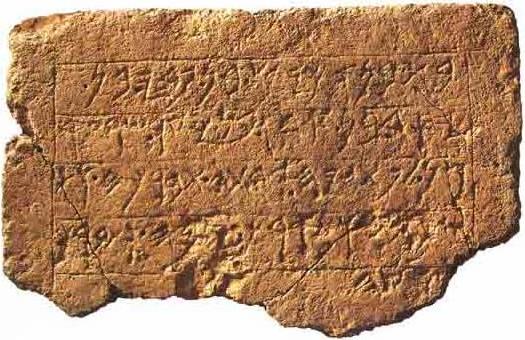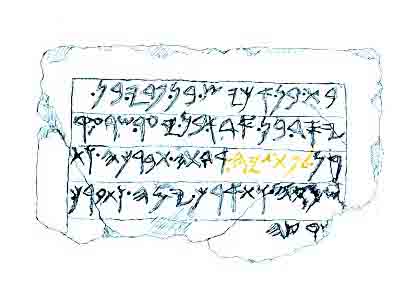Ekron Inscription, early 7th century BCE
The temple (which) Achish son of Padi son of Ysd son of ’Ada’ son of Ya‘ir ruler of Ekron built
for Pt[n]yh, his Lady. May she bless him and ke[e]p him and prolong his days and bless his [l]and. (translated by Aaron Demsky)
The monumental Ekron inscription is dated, stratigraphically and historically, to the first half of the seventh century B.C.E. The five lines of the inscription are enclosed in an incised border (except on the bottom, where the border is broken of). And, mirabile dictu, the inscription itself is both complete and, for the most part, very readable. The words are separated by word dividers in the form of dots.
The inscription calls on a goddess (her name is highlighted in the drawing) to bless king Achish and his land. It is significant that the formula used here, “May she bless him and keep him” (tbrkh vtsûmrh), is reminiscent of the first of the three Priestly blessings as recorded in the Bible (Numbers 6-24)- “May the Lord bless you and keep you” (yevarekhekha YHWH veyishmerekha) and in the inscriptions discovered by Gabriel Barkay at Ketef Hinnom in Jerusalem.
The text is extraordinary in many ways, as the Ekron archaeological team rightly points out. The temple, the inscription tells us, was built by Achish, son of Padi, son of Ysd, son of ’Ada’, son of Ya‘ir, ruler of Ekron. Both Achish and Padi are known from Assyrian records as kings of Ekron. Achish, or as the Assyrians pronounced his name, Ikausu, is one of the kings who provided building materials for the palace of the Assyrian king Esarhaddon (680–669 B.C.E.) in Nineveh.2 Achish also participated in an Assyrian military campaign led by Ashurbanipal (668–627 B.C.E.) against Egypt in 667 B.C.E.3 Although he is identified in the Assyrian sources as king, in the Ekron inscription Achish bears the title sar, which can be translated “ruler” or “mayor.” The official publication of the inscription suggests that the use of sar may indicate that this title expresses the vassal’s loyalty to his Assyrian overlord—or more probably that the word means “king” in a Philistine-Canaanite dialect.
Achish’s father, Padi, is also referred to as king of Ekron in an Assyrian text. Padi was taken prisoner by Hezekiah during the latter’s revolt against Sennacherib (705–701 B.C.E.).4 Now, with the help of the Ekron inscription, we can add three more, earlier rulers to the Philistine dynasty that ruled Ekron in the eighth and seventh centuries B.C.E.—Ysd, ’Ada’ and Ya‘ir.
The name Achish is especially interesting because it is the name of a Philistine ruler of Gath mentioned in the Bible. When David fled from the wrath of King Saul, he joined the company of Achish of Gath (1 Samuel 21-11, 27-2). This Achish is of course not the same as the one referred to in the inscription- The Biblical Achish of Gath ruled in about 1000 B.C.E.; the Achish referred to in the Ekron inscription and in the Assyrian records is his seventh-century B.C.E. namesake. The continuity in names over more than three centuries may indicate that Ekron was the heir of neighboring Gath’s territory and culture.
Discovering a Goddess, Aaron Demsky, BAR 24-05, Sep-Oct 1998. and sidebar “Ekron Inscription,” BAR Sept/Oct 1998.
See also-
- Tel Miqne-Ekron, 7th century BCE
- Ekron of the Philistines, Trude Dothan and Seymour Gitin, BAR 16-01, Jan-Feb 1990.
- Ekron of the Philistines, Part I, Trude Dothan, BAR 16-01, Jan-Feb 1990.
- Buried Philistine Treasures Unearthed at Tel Miqne-Ekron, BAR 19-01, Jan-Feb 1993.
- Excavating Ekron, Seymour Gitin, BAR 31-06, Nov-Dec 2005.





